Nearly Space Disasters, Part 2

We continue the story of space disasters that were prevented by the foresight of the designers of rocketry, the hard work of the MCC, the decisiveness and high training of the crews, or by simple luck.
Soyuz 5
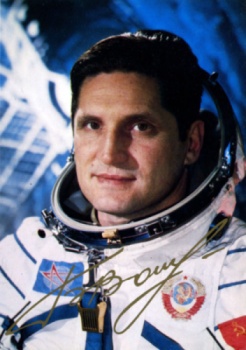
January 18, 1969. The Soyuz-5 spacecraft with astronaut Boris Volynov was returning to Earth after a successful mission. The Soyuz-4 and Soyuz-5 ships made the first Soviet manned docking. The astronauts Eliseev and Khrunov, who started together with Volynov, switched to Soyuz-4 in spacesuits. Eliseev, Khrunov and Shatalov, who started in Soyuz-4, landed safely on January 17th. But Volynov had a deadly problem. The regular landing of the Soyuz spacecraft includes the separation of compartments. Domestic and instrumentation compartments burn out in the atmosphere, and the descent vehicle is landing.
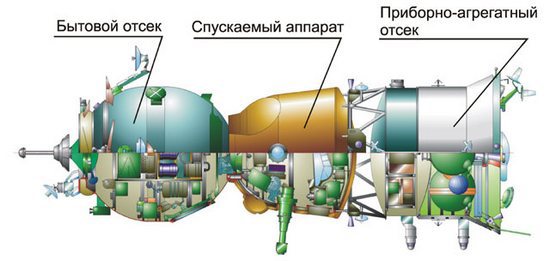
However, the instrument-aggregate compartment (PAO) did not want to separate. Its weight changed the balance of the connected compartments, and, instead of entering forward into the atmosphere with a heat shield, the Soyuz-5 flew upside down:

A layer of thermal protection covers the entire surface of the Soyuz descent vehicle, but it is uneven, and a thin layer on the top can provide protection only for a short time. The cabin began to fill up with burning - the metal of the hatch began to melt, the rubber gasket began to smolder. What did Volynov do? Expecting imminent death and not being able to do anything, he frantically filled the logbook and dictated what was happening on the on-board tape recorder - so that this information would help in the investigation of the disaster and save those astronauts who flew after it. Fortunately, no disaster happened. The precaution of the designers was sufficient. The layer of thermal protection was enough until the moment when the PAO got burnt enough to fall off on its own. However, the problems did not end. The descent vehicle (CA) began to rotate. Inertia of rotation could disrupt the opening of the parachute. The fate of Komarov loomed before Volynov, who died on Soyuz-1 due to the failure of the parachute system. Here is how he describes what is happening:
At an altitude of 80–90 km, the SA, having separated from the PAO, began to somersault, and then gradually switched to rotation around its longitudinal axis. At an altitude of 10 km the parachute system worked. After the main dome came out, the parachute lines began to twist into a harness. Then there was a sharp stop of the rotation of the SA, and there was a rattle of metal. These are the creaking earrings to which the parachute strands are attached. Fortunately, the parachute did not “form”, and the SA began to rotate in the opposite direction, and so it rotated to the very Earth. Therefore, the landing was extremely tough. The blow fell on the shoulders and the back of the head and was so strong that I had a fracture of the roots of the teeth of the upper jaw, but I remained alive ... I saved the lodgement. Then I opened the hatch because it was difficult to breathe from the burning. Ash fell into me, into which the sealing rubber turned
And even after landing, the adventure did not end - before the solemn meeting, the terrorist, who decided to attempt the assassination of Brezhnev, mixed up cars and opened fire on astronauts, firing full clips of two pistols. The driver was killed, a KGB officer was wounded on a motorcycle, and one of the bullets hit Leonov’s overcoat, which was driving in a second car.
Apollo 12

Apollo 12 flight made the ground services nervous. The fact is that at the launch site, the launch rocket was struck twice by lightning. Thanks to the qualifications of the MCC and the astronauts, the alarm caused by the alarm was quickly dealt with , and the mission was not abnormally completed. But a much more terrible danger loomed over the astronauts - a lightning bolt could burn parachute throwers, and in the process of landing the parachutes would simply not open. Astronauts couldn’t check the pyro-ejectors, there was no firm confidence in the refusal, and it was impossible to save the astronauts. Therefore, the MCC, without even informing the astronauts about this danger, continued the mission. Fears did not materialize - the parachutes opened normally, but I think someone in Houston had gray hair.
Apollo 13
And about "Apollon 13" there is a separate publication with a rather detailed story .
Apollo 15

August 7, 1971. The crew of Apollo 15 is returning to Earth. Behind a very successful mission with a stay on the moon for three days and trips on the first lunar "car". At an altitude of 7200 m, the parachute system begins to work - the parachute compartment lid is reset, two braking parachutes are introduced, and, after twenty seconds, three main ones. All three parachutes open normally. The next operation is the dumping of toxic fuel residues of the controlled descent system. Drained nitrogen tetroxide and hydrazine somehow damage three of the six lines of one of the parachutes. The parachute collapses:

It was then that the prudence of the designers came in handy. The fact is that the Apollo parachutes are designed with a margin - and two of them are enough for a normal landing. The astronauts just splashed at a speed slightly more than usual. If the fuel components burned out two of the three parachutes, then only then the integrity of the ship and the lives of the astronauts would be in jeopardy.
Soyuz-15
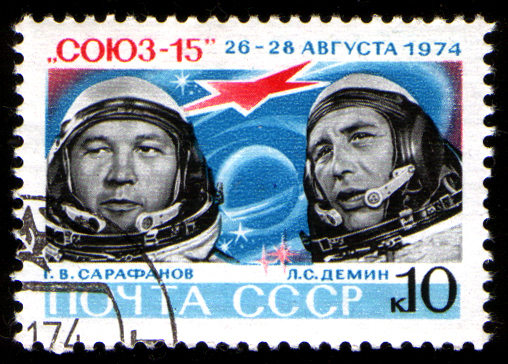
The flight of Soyuz-15 almost led to the first space accident. In the process of approaching the station, the Igla automatic docking system perceived the distance to the station at 350 meters as 20 kilometers and gave an accelerating impulse to a faster approach. The approach speed increased to 20 m / s (72 km / h!) With a permissible speed of 0.3 m / s. Only the lateral speed allowed at a “twenty-kilometer” distance saved the collision - the Soyuz flew past the station at a distance of 40 m. The crew did not realize what was happening and did not intervene in any way. The working "Needle" after the passage of the station deployed the ship and repeated the deadly maneuver two more times. As a result, the PMU was the first to understand the abnormality of the situation. The Igloo was turned off, but there was no longer enough fuel for manual rapprochement and docking.
After the flight to the commission investigating the incident, a conflict arose - the control system developers blamed the cosmonauts for training (“the situation was obviously abnormal, why didn’t they intervene?”), The CPC methodologists defended themselves (“you didn’t give us this refusal and signs of recognition”). Now, from the height of the afterlife, it is clear that both parties are to blame for this incident. The control system developers too believed in their system to carefully analyze possible failures. The CPC methodologists, too, seem to have strong faith in automation, because they did not work out possible problems on their own initiative. After a similar incident with Soyuz-23, the crew quality problem got stronger, measures were taken, already in 1980 at Soyuz-T-2 the failure of the automatic docking system did not disrupt the flight program,
Soyuz-18-1, aka Soyuz-18A
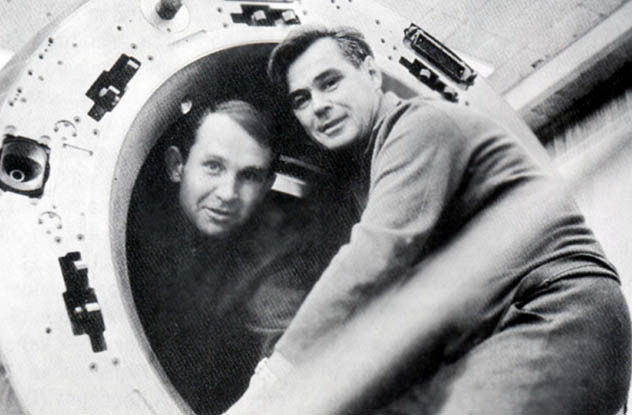
April 5, 1975. A spacecraft is launched to the Salyut-4 orbital station, which should be named Soyuz-18, with cosmonauts Vasily Lazarev and Oleg Makarov. Troubles begin at the separation site of the second and third steps. At 289 second of flight, a command is given to turn off the engine of the second stage. Due to relay failure, a command is issued simultaneously with this command to reset the tail section of the third stage, but only for three out of six locks. Engines of the third stage were already gaining traction, this traction broke the remaining locks, and the tail compartment finally separated:
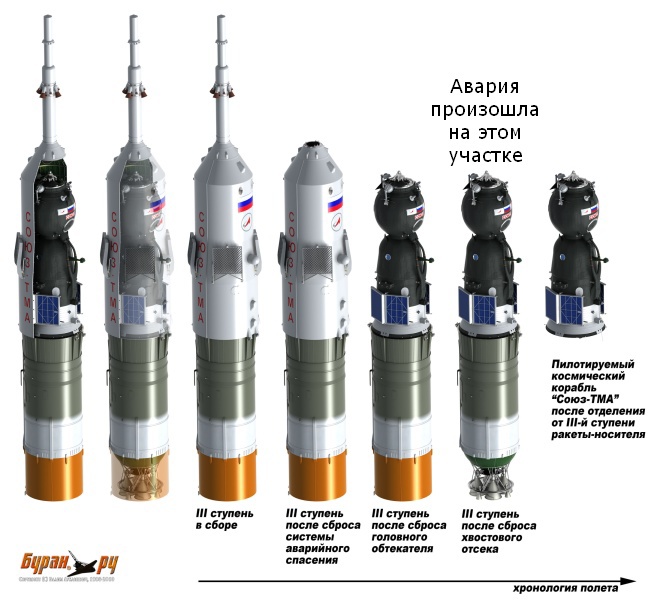
The abnormal step separation process led to angular disturbances - the step with the ship began to rotate at a speed of 20 ° / s and deviate along two other axes at a speed of 5 ° / s. At 295 seconds, the angular disturbances became incompatible with the normal continuation of the flight, the automation of the control system formed the command "Launch of the launch vehicle" and began to save the lives of astronauts. The ship was separated from the third stage, divided into compartments, the descent vehicle turned forward with a heat shield and switched to landing mode. The second problem appeared - during the accident, the controlled descent system “lost” the position of the correct top and bottom, and, instead of reducing the overload, prolonging the braking process, turned the SA over, “burying” it into the atmosphere even more:

As a result, overload reached life-threatening 21.3 g (with a maximum in emergency situations of 15 g). 21 minutes after the launch, the ship landed in the Ore Altai , flying 1574 km from the start. Cosmonaut Oleg Makarov recalls:
The launch of the rocket went fine, we fly, we are waiting for the inclusion of the third stage. But ... suddenly the engine stopped. A siren howled, the RN Accident banner lit up, the car spun sharply, and a “sun bunny” darted through the cab. In the first moments, we did not even understand what had happened. After a few seconds, it became clear that there was some kind of failure in the rocket, and automation separated our ship from it.
They tried to contact the Earth, but there was no radio connection. During the subsequent analysis, it turned out that the radio communication was one-way: the Earth heard us well, and P.I. Klimuk shouted into the microphone, calling us, but we did not hear him. We tried to figure out where to land. Most of all, we were worried that we could get into China, because then we had strained relations with this country. There was a deadly wait ...
While finding out the landing site, weightlessness ceased, and overload came. We did not expect it to be so big. It is known that a person becomes unbearably hard with a 10-fold overload, and with us it was much more.
Vision began to "go away" : first it turned into black and white, and then the angle of view began to narrow. We were in a fainting state, but still did not lose consciousness. While the overload is pressing, you only think that you need to resist it, and we resisted as best we could. With such a huge overload, when it is unbearably hard, it is recommended to scream, and we screamed with all our might, although it seemed like a choked wheeze.
After a few minutes, the overload began to slowly subside. The first thing we caught our breath a bit and began to recover. At this time, the parachute system worked. They landed, the lander swayed a little and stopped. We climbed out and found ourselves on a mountainside covered in snow and a half meters deep. Less than half an hour ago, we flew from Baikonur, it was + 25 ° C, and now we are in the mountains at sub-zero temperatures. They made a bonfire - they warmed themselves. Soon a search plane appeared. We climbed into the descent vehicle and established radio communication with it. To our question, where are we, we were informed that we landed in the Soviet Union in Altai.
We were able to evacuate only the next day. We did not sleep all night and sat around the fire, discussing our emergency flight. Then I thought about how well done those people who foresaw this emergency situation. In abnormal conditions, all the ship's automatic systems worked clearly and as they should. It was like a fairy tale: thanks to people, mostly unfamiliar to us, we safely “returned from the other world”. It was an amazing feeling of some kind of
miracle. That night, Vasily Lazarev and I agreed that from now on we will celebrate this day as our second birthday ...
After this flight, the operation algorithm of the controlled descent system was changed - now in the event of an accident, the descent vehicle began to rotate evenly, making a ballistic descent, which eliminated the effects of orientation errors.
Apollo Union

The American part of the Soyuz-Apollo flight almost ended in tragedy. The problem arose again at the site of landing and drainage of residual fuel. Now, due to an improperly set switch, toxic nitrogen tetroxide began to flow into the Apollo's cabin. Astronaut Vance Brand passed out. The same fate threatened the two remaining astronauts. But Thomas Stafford was already pulling out emergency oxygen masks. Putting on one of them, he quickly handed the mask over to Dick Slayton and put it on Brand. Astronauts received 0.3 ppm of nitric tetraoxide at a lethal dose of 0.4 ppm and lay there for two weeks in the hospital.
Soyuz-23
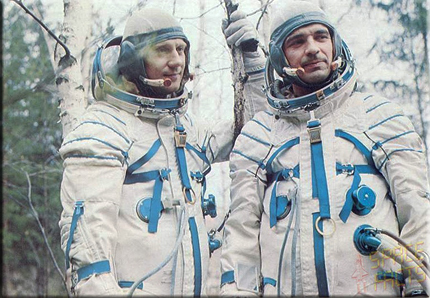
The Soyuz-23 expedition (crew Vyacheslav Zudov and Valery Rozhdestvensky) to the Salyut-5 orbital station took a full sip of pure bad luck. On October 15, 1976, on the second day of the flight, an automatic docking system began to operate abnormally on the long-distance approach site. Inexplicable fluctuations (“fluctuations”) of the signal appeared, which the control system perceived as the ship’s deviation from the approach path, and began to actively maneuver. The inclusion of mooring and orientation engines led to real deviations of the trajectory, which the system extinguished with new impulses, wasting precious fuel. And he, as we recall, in the early "Unions" was very small. The crew did not recognize the problem and did not respond to abnormal ship maneuvers. The MCC was the fastest to deal with the analysis of the situation - the docking was canceled. I had to return to Earth "not salty slurping." And here a real danger awaited.
The night landing, as in the case of Soyuz-15, took place normally, but ended in a phenomenal unlucky hit in Lake Tengiz. Night, snowstorm, and landing on the ice of the lake! The salty water of the lake closes the contacts, and, after the main parachute is shot, the reserve opens. The lander, due to the parachute, lies to one side. The antennas find themselves under water, from rescue helicopters it seems that the Soyuz has drowned. The reality is not much better - the roll of CA led to the fact that the breathing valves were under snow and water, and you can only breathe internal air. Rescuers found the ship, but by this time regeneration cartridges that restore oxygen from carbon dioxide began to run out.
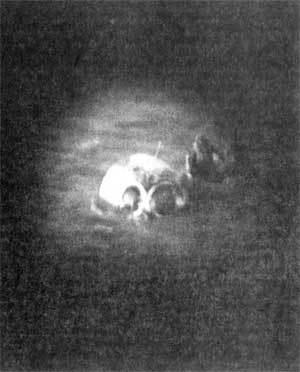
Soyuz-23 lander in water. Nearby in a rubber boat is a lifeguard Nikolai Chernavsky, who, alone, could provide only moral support to the astronauts.
The crew began to experience oxygen starvation. A blizzard did not allow the use of helicopters. By morning, the weather improved, but it was necessary to act very quickly - one of the astronauts had already lost consciousness. In violation of all instructions, with the risk of breaking a helicopter, rescuers began towing the Soyuz with a parachute dragging behind:
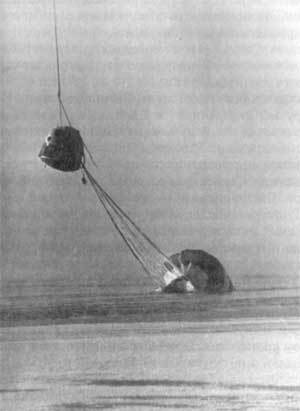
Recalls rescuer Joseph Davydov:
Shortly before the flight to Feodosia, tests were carried out to tow a descent vehicle with crew on board by helicopters and boats. The methods worked out, the towing modes were determined so that the hatch would not be knocked out by the water pressure, and the crew would not drown. I participated in these tests, and now it was clear to me that the Soyuz crew could only be saved by towing. But these recommendations based on the test results have not yet been included in the current instructions of the rescuers, and violation of them in adverse circumstances could bring to court and prison.
There was no time for reflection and coordination with the flight management.
I suggested Nikolai Kondratiev to start towing:
- The instruction is forbidden! - retorted Kondratiev.
“Well, so what, let's wait until they suffocate?” Kolya, there are our comrades! Really, following the instructions, we will wait for their death, - I assured. - We will keep the speed of seven kilometers and everything will be fine, I checked.
“Do you think you can fly at such a speed for a long time?” Engines overheat! Let's get to the bottom! - said Kondratiev, continuing to hold the helicopter over the descent vehicle.
- So that? Will we wait until they suffocate? Forgiveness to you and me, Kolya, will not be!
- Borttehnik, doctor, you are witnesses, a representative of the Cosmonaut Training Center orders me to tow the device.
“If I could order you!” I beg you, I beg you! You are the commander and only you, unfortunately, can make the final decision. And I’m ready to share the responsibility with you. And in the presence of the crew I repeat that I insist on towing - there is no other solution. Either life or death.
Kondratiev transferred the helicopter from the hover mode to the slow forward mode. Through the open door I watched as the lander got out of the icy bitter-salty slurry and crawled behind the helicopter. About two hundred meters the apparatus moved, dropping off the ice crust. Kondratyev watched in tension under the speed instrument, maintaining the speed I called - seven kilometers. He periodically peered into the half-open curtain of the cabin. And although cold air burst into it, drops of sweat appeared on Kondratiev’s face from tension. And suddenly the unexpected. There was a feeling as if a helicopter had hit something viscous, and it was thrown down to the ice of the lake. Kondratyev was not at a loss, reacted, kept the helicopter from falling. Some unknown force dragged him back to the ice of a semi-frozen lake. This unknown and tremendous force that nearly destroyed us, it turned out to be a six-meter canopy of a reserve parachute, which, having jumped out of the container at night, overturned the descent vehicle and violated its alignment, and now, having climbed out of the water to the surface, it filled up with a gust of wind and pulled us to the surface of the lake. Only the experience and instant reaction of Kondratiev saved us from disaster.
The helicopter stiffened, overcoming the terrible power of a parachute-filled canopy. Kondratiev continued to pilot the car and tow the device with a parachute. He did not indulge. I did not order to chop off the towing nylon halyard, although this would be justified in this situation.
Rescuers managed. The ship was towed to the shore and managed to extract pale to blue, but living astronauts. Ironically, the Soyuz-23 crew were backups of the Soyuz-15, which also could not dock with the orbital station and sat down at night. And Valery Rozhdestvensky was the only diver from the set of astronauts.
The bad luck of Soyuz-23 was the only splashdown of the manned Soyuz to date. But all the crews, along with the rescuers, undergo training in case of emergency splashdown - even for the unlikely situation you have to be prepared!
Soyuz-33
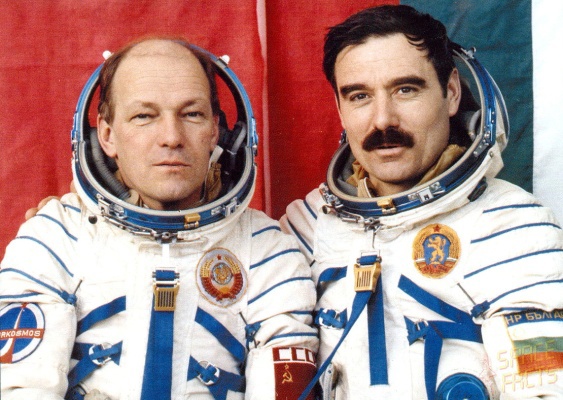
Left Nikolai Rukavishnikov, right George Ivanov.
April 10, 1979. The fourth flight under the Intercosmos program with the first Bulgarian astronaut (whose name was changed from an unhealthy requirement for harmoniousness) will start from the Baikonur Cosmodrome. The flight goes well until the rapprochement phase. The approaching-correcting engine (ACS) gives an impulse of only three seconds instead of 6 seconds, and after that, the proximity and docking system is somehow disabled. Soyuz-33 and Salyut-6 station diverge at a distance of several meters. The MCC allows you to restart the Igloo and try to dock again. The engine behaves abnormally again - it starts with tangible vibrations and immediately turns off. The Salyuta-6 crew reports that they see an abnormal lateral glow in the Soyuz instrumentation compartment. In the heads of MCC personnel and astronauts pops upMartin Caydin’s book and film “In Captivity of the Orbit” is the first failure of the spacecraft’s marching engine in the history of manned space exploration! There is a problem of returning home. Fortunately, Soyuz has many options:
- Return to the redundant corrective engine (DCD), which is specifically for such cases.
- Use low-power mooring and orientation engines (DSP), which are used for docking.
- Trying to squeeze at least some impulse from an incompletely failed SKD.
- Trying to bring not the ship to the station, but the station to the ship (Salut had its own engines), and only then dock at the DPO. The astronauts can spend a month or two at the station and try to repair the ship or wait for a new ship (from the next planned expedition), which theoretically can be prepared more quickly.
The simplest and safest is chosen - braking on the DCD. He also presented a surprise - refused to turn off at the estimated second. The astronauts faced the question - turn off? And if the engine gives an impulse below the calculated one, and smart automation tries to compensate for this, forcing it to work longer than the calculated one? DCD once, you can’t turn it on again. But you need to decide quickly! Rukavishnikov gives the DCD to work out the extra 25 seconds and turns off the engine. The report in the MCC - the "earth" for some reason is silent. A few more painful minutes. Finally, the MCC responds, and twenty-five minutes later the string of the toy is pulled - the “weightlessness indicator”. The ship enters the atmosphere. After such experiences, the fact
And the crew of Soyuz-32, which is already at the station with an engine of the same series as the one that failed on Soyuz-33, is waiting for a new Soyuz-34 with a carefully selected new engine and is safely returning to Earth. And Soyuz-32 sits in an unmanned version, without experiencing any problems with the engine.
What next?
And the events after 1979 will be the next part.
List of sources used
In addition to Wikipedia, the following were used:
- Chertok Boris Evseevich, “Rockets and People” in 4 books.
- Kamanin Nikolay Petrovich, “Hidden Space”, diaries in 4 books.
- “When We Left Earth”, Discovery Channel, TV series 2008.
- Encyclopedia “World Manned Cosmonautics: History. Equipment. People "under the editorship of Yu.M. Baturin.
- Davydov Joseph, “The Triumph and Tragedy of Soviet Cosmonautics. Through the eyes of the tester
For navigation: a series of "space disasters and incidents . "
